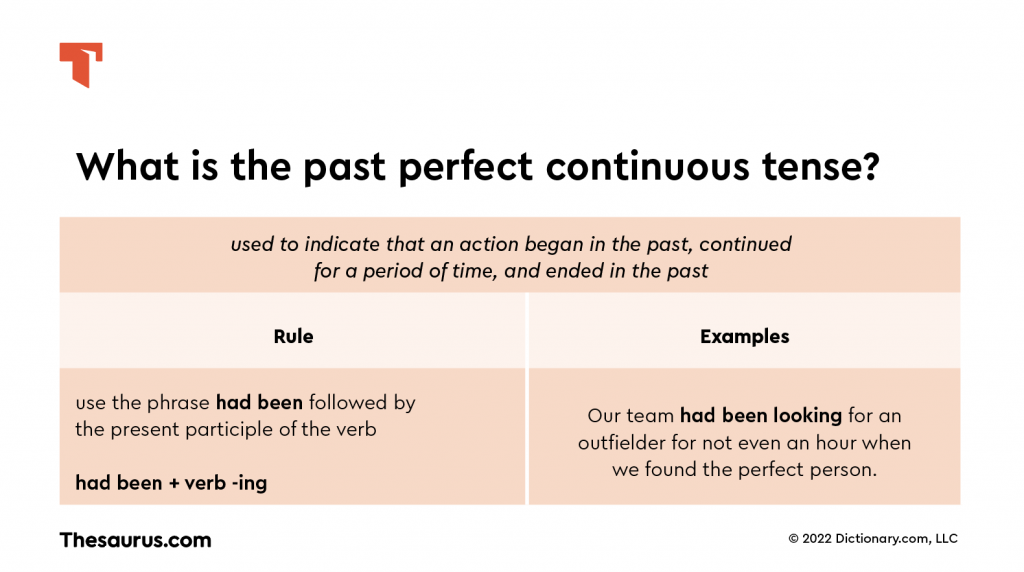Something amazing happened the other day. Two teenagers had been cleaning their garage for a while when suddenly a group of ninjas appeared! The teens were surprised, but they had been watching action movies for years, so they were prepared to do battle. As it turned out, the ninjas were actually a troupe of actors who had been looking for someone to direct them to the theatre. Luckily, the misunderstanding was solved before anyone engaged in a fight they had been hoping to avoid anyway. This story is admittedly pretty silly, but it also has several examples of a neat bit of grammar: the past perfect continuous tense.
What is past perfect continuous tense?
We use words called verbs to refer to actions or states of being. In English, we have 12 different types of verb tenses to describe all of the events that happen. Generally speaking, the tense of the verb tells you when in time an action or state occurs. The past perfect continuous tense tells us that an action occurred in the past, continued for a while, and then ended before the present time.
If we examine the name of this verb tense, we can see that it is telling us how to use it:
- Past: This verb tense refers to an action/state that happened before now.
- Perfect: Generally speaking, perfect verb tenses refer to completed actions.
- Continuous: Continuous verb tenses refer to actions/states that continue(d) over a period of time or are/were in progress.
Putting it all together, the past perfect continuous tense typically refers to an action that happened in the past, continued for a period of time, and then completely ended in the past.
The following sentences all contain examples of verbs in the past perfect continuous tense:
- I had been taking a nap when the earthquake rocked my house.
- She had been eating meat for years before she became a vegetarian.
- The dogs had been barking constantly until their owner fed them.
Before perfecting this tense, you might want a review on the present continuous tense first.
When do you use past perfect continuous?
There are several common ways to use the past perfect continuous tense. The main reason that we use the past perfect continuous tense, also called the past perfect progressive tense, is to indicate that an action:
- began in the past;
- continued for a period of time;
- ended in the past.
For example, the sentence I had been working as a lawyer until I decided to get a degree in psychology says that I began working as a lawyer sometime ago, continued to work as one for a while, and then stopped working as one once I earned a degree (which also happened in the past). Importantly, this sentence implies that I am not working as a lawyer now.
Look at the following example sentences that correctly use the past perfect continuous tense, and you will see that they both refer to actions that began and ended in the past:
- My daughter had been asking me to buy her a car for years before I could finally afford to get her one.
- The champion boxer had been winning every match in the first round until he was suddenly beaten by a mysterious challenger.
Because the past perfect continuous tense refers to actions that ended, we often use a subordinating conjunction such as before, since, until, and when to state what other event or time limit caused them to stop. We also often use the conjunction because with the past perfect continuous to explain the cause of a past event as in The knights were on high alert because Robin Hood had been stealing from wealthy merchants.
There are two important things to remember about the past perfect continuous tense:
1. We do NOT use this verb tense to refer to actions that continue to the present moment. In that context, we use the present perfect continuous tense.
For example, the sentence I had been waiting for Kevin for two hours means that I spent two hours in the past waiting for Kevin, but I am not waiting for them anymore. By contrast, the sentence I have been waiting for Kevin for two hours means that I have spent two hours waiting for Kevin, and I am still waiting for them right now. It is important to take a moment to think about what you are trying to say in your sentence before choosing which of these two verb tenses to use.
2. As in all other continuous verb tenses, we typically do not use the past perfect continuous tense with stative verbs. Stative verbs (such as like, want, or believe) refer to states of being so it usually does not make sense to use them in the past perfect continuous tense. Instead, we use stative verbs in the simple past tense or past perfect tense.
For example, we generally don’t say The Roman Empire had been existing for over a thousand years when it collapsed. Rather, we say The Roman Empire existed for over a thousand years until it collapsed (simple past) or The Roman Empire had existed for over a thousand years when it collapsed (past perfect).
Review the simple past tense to know exactly how to simply talk about … the past.
How to form past perfect continuous tense
Forming the past perfect continuous tense is pretty simple. In order to do so, we use the phrase had been followed by the present participle of the verb. The present participle is a form of the verb that ends in -ing. For example, the present participle of drink is drinking. All verbs follow this pattern regardless of number (singular or plural) or person (first, second, or third).
You can see that the verbs in the following sentences all follow the same structure when used in the past perfect continuous tense regardless of what the subject is.
- I think my cat had been sleeping for 20 hours when I woke her up.
- Our team had been looking for an outfielder for not even an hour when we found the perfect person.
- My parents had been living by the beach for 40 years when the tsunami destroyed their home.
How to make past perfect continuous tense negative
In order to make the past perfect continuous tense negative, all you need to do is stick the word not between the words had and been. The contraction hadn’t can also be used. These sentences all use the past perfect continuous tense in the negative:
- I had not been eating for even five seconds when the telemarketer interrupted my dinner.
- I hadn’t been eating for even five seconds when the telemarketer interrupted my dinner.
- We did not think Lisa was ready for the big show because she had not been practicing her lines much at all.
- We did not think Lisa was ready for the big show because she hadn’t been practicing her lines much at all.
- According to his coworkers, the suspect had not been working at the jewelry store for even a week when the diamonds went missing.
- According to his coworkers, the suspect hadn’t been working at the jewelry store for even a week when the diamonds went missing.
What else is perfect? Your writing
Improve your writing with Thesaurus.com’s Grammar Coach™, which catches grammar and spelling errors and provides Thesaurus-powered synonym suggestions. Using machine learning, this tool can spot the difference between the different verb tenses, making sure you’re using them correctly—and much more! Whether you’re writing in the past, present, or future, perfect grammar has never been easier.















